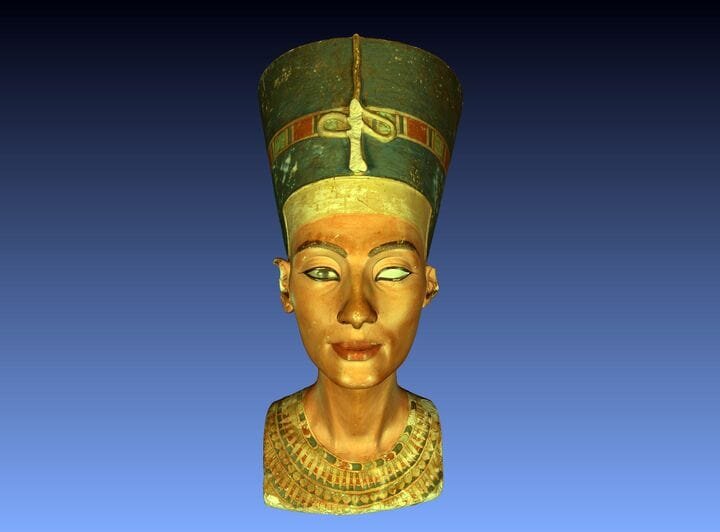![Front view of the official Nefertiti 3D scan [Source: Fabbaloo]](https://fabbaloo.com/wp-content/uploads/2020/05/nefertiti-scan_img_5eb08cc226dc8.jpg)
After years of effort, 3D scanning enthusiast Cosmo Wenman has persuaded authorities to release a high quality 3D scan of Egyptian Queen Nefertiti.
This is the long-awaited follow-up to our 2016 story that described a highly unusual situation involving ancient egypt, a German museum and 21st century technology.
Nefertiti Sculpture
The original Nefertiti was discovered by German archaeologist Ludwig Borchardt in 1912, and from there it was transferred to Germany to be held by a series of museums. Since 1920, the 3,364 year-old sculpture has been exhibited by the Neues Museum in Berlin. I’ve personally seen the beautiful sculpture in person, but do not have any images because the museum did not allow pictures to be taken of the sculpture.
Evidently the Museum folks were quite protective of their sculpture.
At that time there was significant interest in capturing detailed 3D scans for the public. In fact, we posted a six-part series on how to 3D scan sculptures in museums. But the Neues Museum officials would not allow this. However, they did internally hire professionals to capture a full and highly detailed 3D scan of Nefertiti.
But they refused to release the 3D scan to the public.
Nefertiti Hacked Scan
Then, in 2016, a group came forward to explain they had somehow smuggled a Kinect 3D scanner into the Nefertiti exhibition room at the Neues Museum and surreptitiously captured their own detailed 3D scan.
This scan was posted publicly, but questions immediately arose.
The detail of the scan was quite high, far higher than one could possibly achieve with a Kinect rig. Also, everyone could not believe that a highly visible Kinect scanning operation would not have been noticed by someone at the museum.
![My 3D print of the unofficial Nefertiti 3D scan [Source: Fabbaloo]](https://fabbaloo.com/wp-content/uploads/2020/05/image-asset_img_5eb08cc269a05.jpg)
Nevertheless, the “illegal” 3D scan was posted and used by many. I’ve 3D printed it myself, as shown here, and it is a wonderfully detailed 3D model.
Freeing Nefertiti
In the meantime, 3D scan enthusiast Cosmo Wenman was at work to persuade the Neues Museum to release the 3D scan to the public. After all, their fears of loss of income or loss of ownership of the design were entirely unfounded. In fact, the original sculpture itself was literally stolen by the German researchers from Egypt.
Now, after three years of effort, Wenman announced that the actual, legal full 3D scan made by the museum is cleared for release to the public. Wenman, who is responsible for a number of highly detailed 3D scans of sculptures, posted the full 3D scan on Thingiverse for all to access free of charge.
Be warned, however, it’s a very large 3D scan. The .OBJ file alone is 845.7MB, and there are 6.4M faces to the model! Here you can see the level of detail around Nefertiti’s right eye. Incredible!
![Extreme detail of the official Nefertiti 3D scan [Source: Fabbaloo]](https://fabbaloo.com/wp-content/uploads/2020/05/nefertiri-eye_img_5eb08cc2bb949.jpg)
In a lengthy post, Wenman describes the torturous route he took to convince the museum folks to release the 3D scan. He used a variety of techniques, including freedom of information requests, to attempt to access the scan. These failed, but Wenman proceeded to attack their main defensive argument: releasing the scan would adversely affect the museum’s gift shop replica sales.
In a brilliant move, Wenman requested the museum’s gift shop revenues, and found that there were virtually no sales and thus their argument collapsed.
Nefertiti 3D Model License
![CC license on the bottom of the official Nefertiti 3D scan [Source: Fabbaloo]](https://fabbaloo.com/wp-content/uploads/2020/05/image-asset_img_5eb08cc315f22.jpg)
Wenman received a USB stick with the 3D scan shortly thereafter, whereupon he discovered they had emblazoned a license on the bottom of the 3D model. That license is the Creative Commons “CC BY-NC-SA” license.
This meant that anyone, including Wenman, could publish the 3D model publicly, so long as the license terms were adhered to. Wenman quickly did so by posting the entire 3D model to Thingiverse, where all can freely access it.
But a question remains: what was the “illegal” 3D scan? Was it a pirated copy of the original 3D scan? In a post on SkepChick, Wenman was asked this question:
”Like most 3D models, the surfaces of both the “hack” scan and the museum’s scan are each defined by a mesh that is made of lots of triangles. The “hack” scan has 2 million triangles. The museum’s scan has 6.4 million — more than three times as many. The two scans’ surfaces are nearly identical, except the extra triangles in the museum scan define features at a finer resolution than the hack scan. Also, the hack scan has no color data, but the museum’s scan has full color info.”
So it seems they are different 3D scans, and to this day no one really knows for certain where it came from.
Except those who did the job.
Via Thingiverse, Reason and SkepChick

